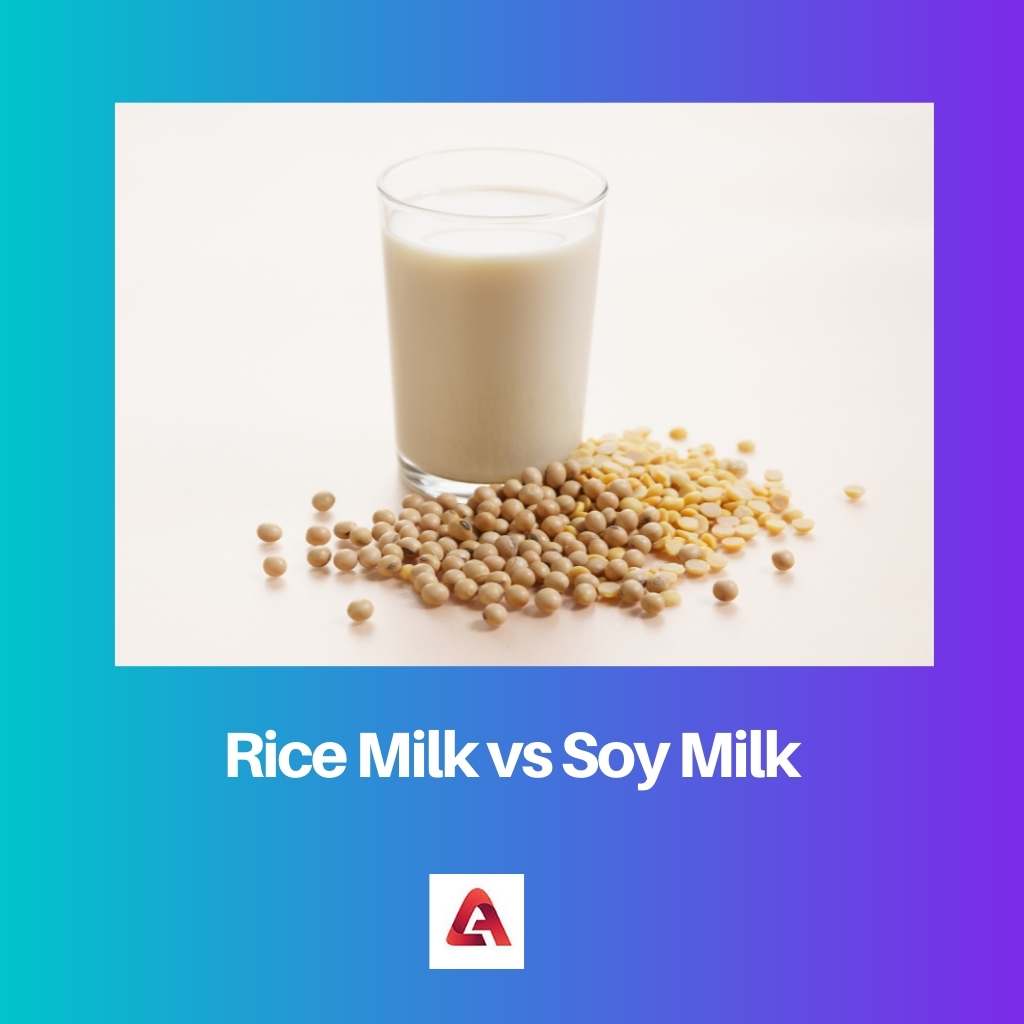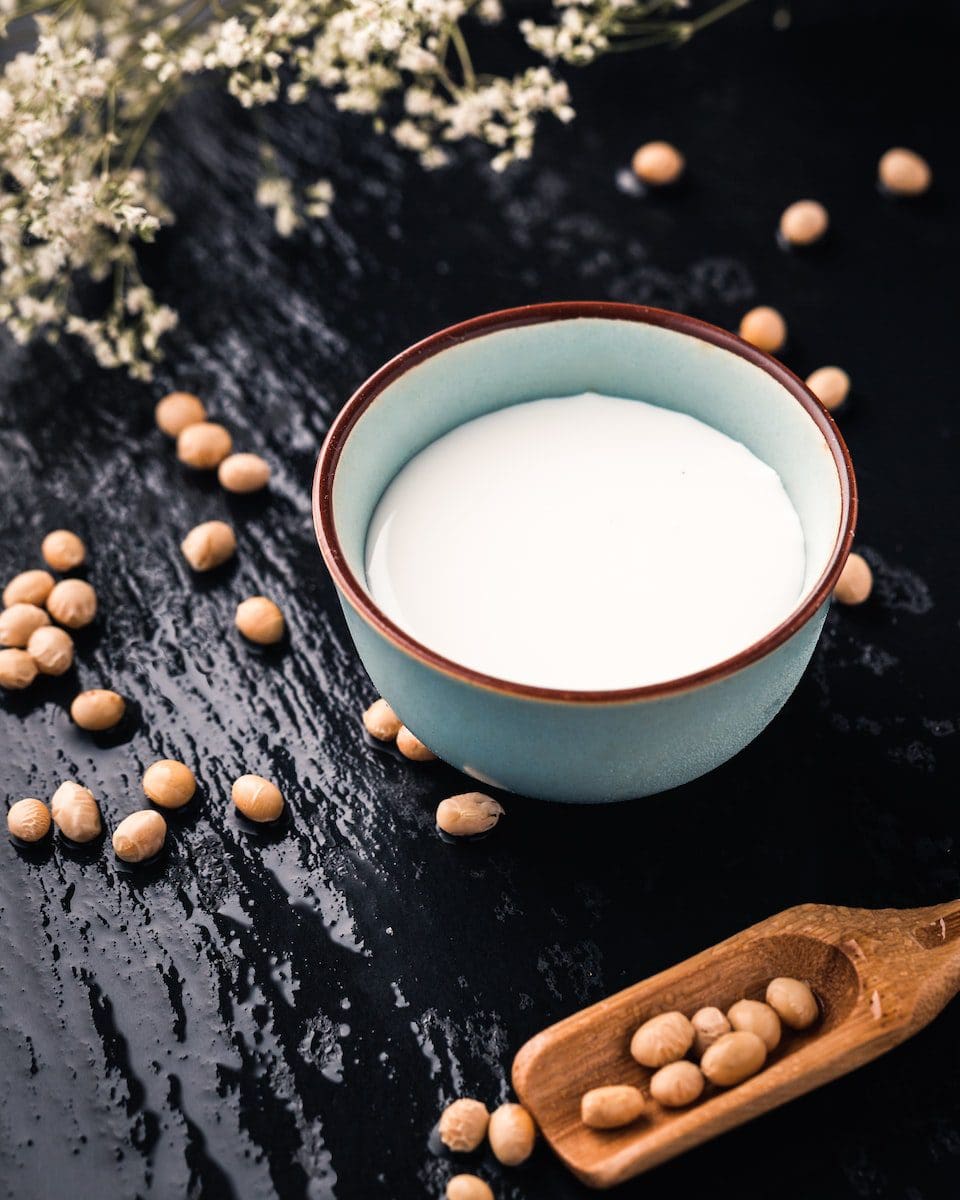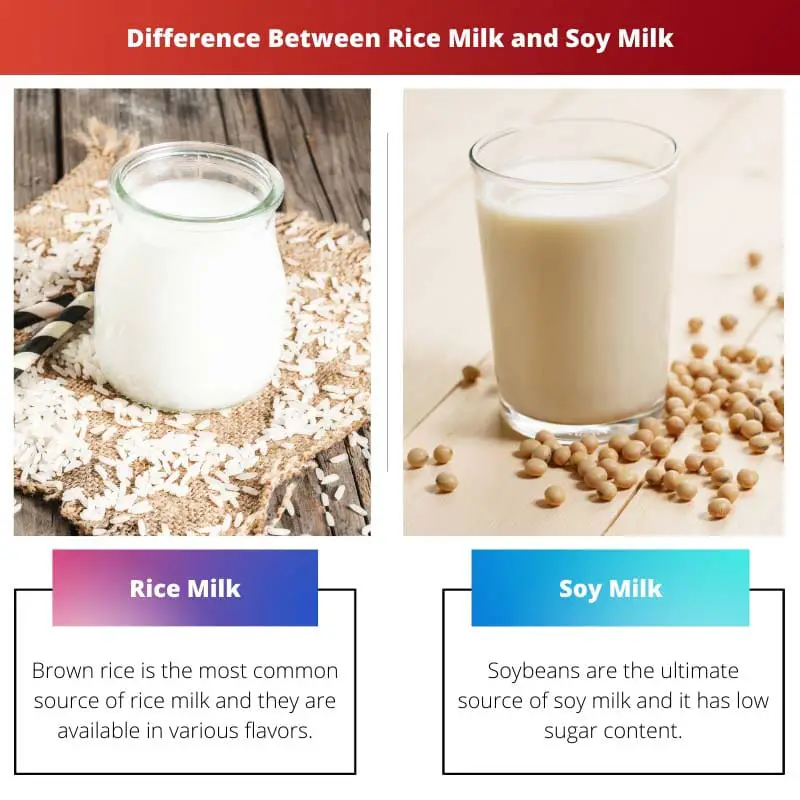With veganism gaining more popularity, replacements for animal-based products are a big catch in today’s market. Milk is one of the most common dairy products that act as a good source of high-quality protein and fat.
Plant-based milk like rice and soy milk are on every vegan and health-conscious person’s grocery list. Different plant-based milk provides different nutritional values that increase the number of choices for us.
Key Takeaways
- Rice milk is a dairy-free milk alternative made from rice, while soy milk is a dairy-free milk alternative made from soybeans.
- Rice milk is thinner and sweeter than soy milk, while soy milk has a thicker consistency and a nuttier flavor.
- Rice milk is hypoallergenic and suitable for people with lactose intolerance, while soy milk is a good source of protein and suitable for vegan people.
Rice Milk vs Soy Milk
Rice milk is made by blending rice grains with water and then straining out the solids, resulting in a smooth, creamy liquid that is slightly sweet in flavour. Soy milk is higher in protein, made by soaking and grinding soybeans and then boiling the mixture to extract the milk-like liquid.

Rice milk is a popular alternative to any animal milk, and it is one most hypoallergenic milk products. It has the least amount of fat compared to other plant-based milk and is cholesterol-free.
Though rice milk is a good substitute for people who are lactose intolerant or have nut allergies, it is not a good choice for diabetic patients because of its high carbohydrate.
Soy milk is more popular than rice milk as it contains high-quality proteins, essential omega-3 fatty acids, and very sugar content. One cup of soy milk contains 80 calories which is more than the calorie content of almond milk.
Some studies show that the consumption of soy milk reduces the risk of osteoporosis and heart disease.
Comparison Table
| Parameters of Comparison | Rice Milk | Soy Milk |
|---|---|---|
| Source | Brown rice is the most common source of rice milk and they are available in various flavors. | Soybeans are the ultimate source of soy milk and it has low sugar content. |
| Processing | Rice goes through a milk stream which is converted into a paste. The liquid obtained from it is rice milk. | The soybeans are soaked in water and grounded to make a fine paste. The paste is strained to obtain soy milk. |
| Nutritional value | Rice milk contains 22 grams of carbohydrate and 2 grams of fat per cup. It is a good source of vitamin B and antioxidants. | Soy milk contains 4 grams of carbohydrate and fat each per serving. It is also a good source of high-quality protein. |
| Consistency | Rice milk doesn’t have a very thick consistency as it contains very little natural fat. Many brands use tapioca to thicken it. | Soy milk has comparatively a thicker consistency as compared to rice milk and almond milk. |
| Calorie Content | Standard flavorless rice milk contains 120 calories per cup of serving. | Standard flavorless soy milk contains 80-100 calories per cup of serving whereas light soy milk contains 50 calories for the same quantity. |
| Origin | In the early 21st century, rice milk became popular as Vita Rice Products Co started selling it in California. | Soy milk is originally from China but in the second half of the 20th century, it became a common drink in North America and Europe. |
| Diabetic Patient | Rice Milk is not appropriate for diabetic patients as it contains 3-4 times more carbohydrates than soy milk. | Soy milk is a better choice for diabetic patients because of its low sugar content and ability to decrease blood glucose levels. |
What is Rice Milk?
Rice milk is a plant-based beverage that is available commercially in many flavours. Apart from using brown rice and water, the main ingredients for manufacturing rice milk, the commercial products also contain many plant-based oils, sweeteners, and flavourings.
One cup of rice milk contains 120 calories. They have high carbohydrate and calcium content. It is also rich in vitamins A, B12, and D.
To meet the nutritional need, rice milk is sometimes fortified with micronutrients, and to make it taste, various good flavours like chocolate, vanilla, etc. are added.
Rice milk has various health benefits, including improving bone density (presence of Vitamin D and calcium), preventing Vitam B12 deficiency (a deficiency that causes fatigue, weakness, megaloblastic anaemia), etc.
It is not appropriate for diabetic patients because it contains high carbohydrates.
What is Soy Milk?
Soy milk is a better plant-based milk option than rice milk because of its high protein and essential fatty acid content. If one doesn’t have alternate allergy directions from soybean, then he/she can replace animal milk with soy milk.
But, they are a bit expensive as compared to other kinds of milk.
Soy milk can reduce obesity and high blood pressure and maintain a healthy body weight. It is also rich in vitamins and minerals and improves the health of the heart, combined with a low cholesterol level.
Soy milk is also known for curing hyperpigmentation and has anti-ageing properties. Some of the other health benefits are increasing bone density, better hair growth, antidepressant, etc.

Main Differences Between Rice Milk and Soy Milk
- Brown rice is the most common source of rice milk, whereas soybeans are the ultimate source of soy milk.
- Rice goes through a milk stream which is converted into a paste, whereas the soybeans are soaked in water and grounded to make a fine paste,
- Rice milk contains 22 grams of carbohydrates and 2 grams of fat per cup, whereas soy milk contains 4 grams of carbohydrates and fat each per serving.
- Rice milk doesn’t have a very thick consistency as it contains very little natural fat, whereas soy milk has a comparatively thicker consistency.
- Standard flavourless rice milk contains 120 calories per serving, whereas standard flavourless soy milk contains 80-100 calories per serving.
- Rice Milk is not appropriate for diabetic patients as it contains 3-4 times more carbohydrates than soy milk. On the other hand, soy milk is a better choice for diabetic patients because of its low sugar content and ability to decrease blood glucose levels.

- https://www.ima.org.il/filesupload/imaj/0/38/19354.pdf
- https://link.springer.com/content/pdf/10.1007/s003940050055.pdf
Last Updated : 11 June, 2023

Sandeep Bhandari holds a Bachelor of Engineering in Computers from Thapar University (2006). He has 20 years of experience in the technology field. He has a keen interest in various technical fields, including database systems, computer networks, and programming. You can read more about him on his bio page.





The detailed examination of rice milk and soy milk in the article offers a comprehensive comparison of their nutritional value and suitability for different dietary needs. The insights provided in the comparison table are particularly helpful in understanding the unique characteristics of these plant-based milk alternatives.
The article’s thorough examination of rice milk and soy milk provides valuable information on their nutritional content, processing methods, and health benefits. Understanding the differences between these milk alternatives is crucial for individuals seeking plant-based alternatives to animal-based products.
I appreciate the detailed comparison of rice milk and soy milk, particularly in terms of their nutritional value and suitability for specific dietary requirements. The article provides valuable insights into the distinct characteristics of these plant-based milk options.
The article’s analysis of the differences between rice milk and soy milk is highly informative, especially in highlighting their nutritional value and health benefits. Consumers can make well-informed decisions about their dietary choices based on the information provided in the article.
The article provides valuable insights into the differences between rice milk and soy milk, particularly in terms of their nutritional value and suitability for various dietary preferences. The detailed comparison table is particularly helpful in understanding the distinctions between these plant-based milk alternatives.
The article’s comprehensive comparison of rice milk and soy milk sheds light on their distinct nutritional value and health benefits. Consumers can gain valuable insights into the differences between these plant-based milk options to make informed decisions about their dietary choices.
I agree with the detailed analysis of rice milk and soy milk in the article. The comparison table provides a clear overview of their differences in processing, nutritional value, and potential health benefits, enabling consumers to make informed choices based on their dietary requirements.
The article’s examination of rice milk and soy milk offers valuable insights into their nutritional content and health benefits, providing consumers with a clear understanding of the unique characteristics of these plant-based milk alternatives. It’s essential to consider the differences in processing, origin, and suitability for specific dietary preferences.
The article provides a comprehensive comparison between rice milk and soy milk, highlighting their nutritional value and health benefits. It’s essential to consider the differences in origin, consistency, calorie content, and processing. It’s also worth noting that rice milk is not recommended for diabetic patients due to its high carbohydrate content.
I agree with the information presented in the article. The comparison table provides a clear overview of the key differences between rice milk and soy milk, making it easier for consumers to make an informed choice based on their dietary needs.
The detailed analysis of the nutritional value and processing methods of rice milk and soy milk is insightful. It’s important for consumers to be aware of the differences to make informed choices when it comes to plant-based milk alternatives.
The article offers a comprehensive overview of the nutritional content and health benefits of rice milk and soy milk. It’s crucial for consumers to be well-informed about the distinct characteristics of these plant-based milk options to make informed decisions about their dietary choices.
The comparison of rice milk and soy milk in the article provides a clear understanding of their differences in consistency, calorie content, and suitability for specific health conditions such as diabetes. This information is essential for consumers seeking alternatives to animal-based milk products.
The detailed comparison of rice milk and soy milk in the article is highly informative, particularly in shedding light on their nutritional value and potential health benefits. It’s essential for individuals to consider the unique characteristics of these plant-based milk alternatives when making dietary choices.
The article offers a thorough examination of the health benefits and nutritional values of rice milk and soy milk. It’s important for individuals to understand the potential impact of these milk alternatives on their health and dietary requirements.
I appreciate the detailed comparison of rice milk and soy milk. It’s crucial to highlight the differences in protein content, calorie intake, and origin of these plant-based milk options to provide valuable information to consumers.